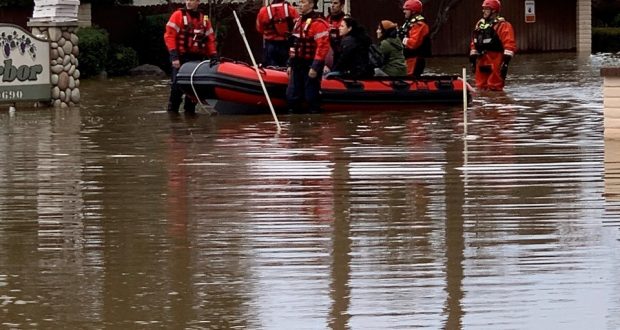By Aldon Thomas Stiles| California Black Media
Over the last few weeks storms have torn through many of California’s communities, prompting evacuations in areas like Planada and Merced due to widespread flooding.
There have been at least 19 fatalities due to storm related incidents, according to the Governor’s Office of Emergency Services.
Friday, January13, marked the end of the seventh storm and beginning of the eighth storm in a series of nine storms.
That day, Gov. Newsom paid a visit to Santa Barbara, joining first responders, volunteers, and members of Cal Guard as they filled sandbags in preparation for the storm to come.
“The magnitude of this is not isolated to smaller communities, it is scaled across the largest state in our union,” Newsom said at a press conference held in Santa Barbara.
Newsom said that Californians can expect these storms to continue through at least the 18th of this month.
But what does this mean for the state’s long-standing drought?
Since 2019, California has been experiencing its driest period in 1,200 years, according to a study published by Nature Climate Change.
Molly White, the State Water Project’s Water Operations Manager, says that the statewide reservoir storage sits at 87% of the historical average, surpassing the 2021 and 2022 levels.
“We’re certainly, across the state, seeing an increase in storage with this storm activity,” White said during a presentation hosted by the California Department of Water Resources (DWR).
However, there are variations in water storage from county to county.
This has much to do with how areas get their water supply as some areas rely on groundwater – which usually accounts for about 30% to 60% of the state’s total water supply, depending on the year; others rely more heavily on surface storage.
Tim Godwin, DWR Supervising Engineering Geologist at the Sustainable Groundwater Management Office, talked about how the framework for groundwater storage is outlined in the Sustainable Groundwater Management Act (SGMA).
Signed in 2014, SGMA was conceived to protect water present below the earth’s surface by requiring local agencies to form groundwater sustainability agencies to manage water in their respective regions.
“Groundwater is best managed locally,” Godwin said during the online presentation. “It also acknowledges that groundwater and surface water are intimately connected.”
The Flood Operations Center (FOC) has identified six focus areas critical in the flood prevention effort: the Pajaro River in Santa Cruz and Monterey County, the Salinas River in Monterey County, the Cosumnes River in Sacramento County, Bear Creek River in Merced County, the Russian River in Mendocino and Sonoma County, and the State-Federal Flood Control system in Sacramento and the San Joaquin Valleys.
Even when the storms slow, state officials claim that water levels will remain high due to the fluctuations in some of these target areas.
On Jan. 14, President Joe Biden approved the state’s emergency declaration, making federal funding available for Merced, Sacramento, and Santa Cruz.
Additionally, Newsom proposed $202 million in flood prevention in the 2023-2024 budget proposal.
Newsom claimed that these storms – and other tumultuous weather conditions are not happenstance, but a symptom of climate change.
“Megadroughts. Wildfires. Historic floods and atmospheric rivers. This whiplash weather is not an anomaly. California is proof that the climate crisis is real, and we have to take it seriously,” Newsom tweeted.
Newsom commended those who have been at the front line of these treacherous storms.
“I couldn’t be more proud of the first responders and everyday Californians stepping up across the state to help support communities impacted by these ongoing storms,” Newsom said in a statement. “With more difficult days ahead, it’s critical that Californians stay alert to conditions in their area and follow guidance from local emergency responders to stay safe.”
 Westside Story Newspaper – Online The News of The Empire – Sharing the Quest for Excellence
Westside Story Newspaper – Online The News of The Empire – Sharing the Quest for Excellence





